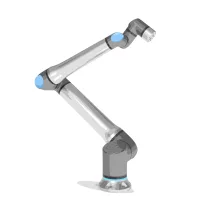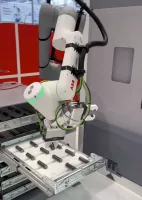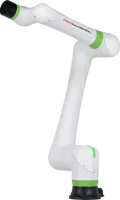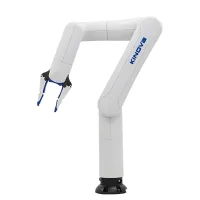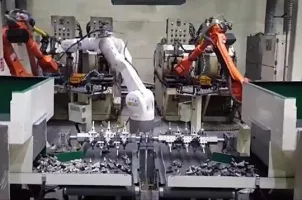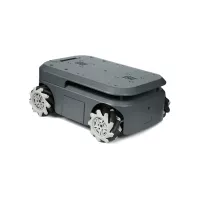ELEVATE YOUR MATERIAL HANDLING OPERATIONS IN TODAY'S MARKET
Learn how the latest in material handling tech makes work safer and faster.
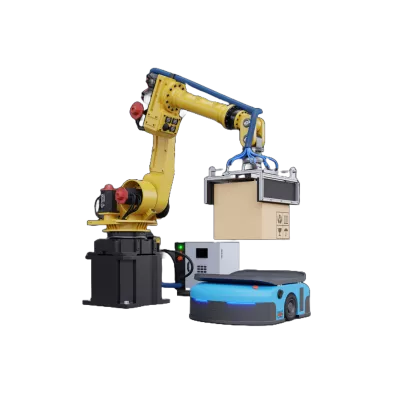
1. What is Material Handling?
Material handling is all about moving materials around in a smart and safe way, whether it's inside a warehouse or between a warehouse and a truck. It's not just about moving things from point A to point B; it's also about keeping your goods safe, making sure they're in the right spot, and managing them efficiently.
You might see people doing this by hand, but often, there are machines and technology involved to make the job easier and faster. This could be anything from forklifts to move pallets, conveyor belts to transport items across a building, or even robots that pick up and sort products.
The goal is to make sure everything runs smoothly, from when a product arrives until it's ready to be sent out. This helps your business save time and money, keeps workers safe, and makes customers happy by getting their products to them faster and in good shape.

2. Why is Material Handling Important?
Material handling is super important because it keeps everything in your warehouse or factory moving smoothly. Think of it like the bloodstream of a warehouse, where products need to flow without any hiccups. First off, it helps keep your products safe. Nobody wants damaged goods, right? By moving things carefully and efficiently, you make sure everything stays in tip-top shape.
Then, there's the time and money aspect. Good material handling means you can move products faster, which saves you time. And time is money. It also means you're using your space wisely, so you don't need to pay for extra storage.
Plus, it's all about making your workers' lives easier and safer. With the right equipment, they don't have to lift heavy items by hand, reducing the risk of injuries. In short, effective material handling boosts your productivity, saves costs, and keeps everyone safe. It's a win-win-win!
Featured Material Handling Cobots:
3. What are the Types of Material Handling Equipment?
In material handling, there are lots of cool tools and robots designed to make moving stuff around easier and safer for you:
Cobots:
These friendly robots work right next to people. They're safe and help with tasks that need a gentle touch.
Mobile Robots:
Imagine smart carts that move around on their own, carrying items from one spot to another without bumping into things.
Industrial Robots:
These are the strong arms of the robot world. They lift and move heavy things with great care, perfect for big jobs.
Vision Systems:
Robots with special cameras (2D and 3D vision systems) that help them see and sort things out, like which item goes where.
Grippers:
These are like robot fingers that can pick up and hold onto stuff, moving it wherever it needs to go.
Robot Software:
This is what tells all the robots what to do and when to do it, making sure everything runs smoothly.
These gadgets and robots help make sure everything in your warehouse or factory moves smoothly, quickly, and safely, making your job a lot easier.
4. How Does Automation Impact Material Handling?
Automation has a big impact on how material handling is done, making things quicker, safer, and more efficient for you. Here's how some of the tools we talked about earlier fit into this:
Faster Work:
With robots like cobots, SCARA, and mobile robots, tasks that used to take a lot of time can now be done much faster. These robots can work around the clock without getting tired, speeding up everything from picking items to packing them.
Fewer Mistakes:
Robots are precise. Whether it's using 3D vision systems to spot defects or robot software to manage inventory, automation reduces errors. This means fewer wrong orders and happier customers.
Safer Environment:
Automation means fewer chances for accidents. Cobots, for example, are designed to work safely alongside humans, reducing the risk of injuries.
Saves Money:
While there's an upfront cost, automation saves money in the long run. Robots can do the work of several people and don't need breaks, making your operation more cost-effective.
5. What are the Basic Principles of Material Handling?
Let's talk about the key rules that make material handling work best for you:
Plan Ahead:
Just like planning your day makes things go smoother, planning how to move stuff around helps avoid problems.
Use the Space Well:
Think of it like a game of Tetris. Using your space smartly means you can fit more stuff in without it getting messy.
Work Smart:
Using cool tools like mobile robots or cobots means you can do tasks quicker and with less effort.
Stay Safe:
Keeping everyone safe is super important. Using safety scanners and making sure robots and people can work together safely is a big part of this.
Keep Improving:
Always look for ways to do things better, whether it's updating your robot software or finding new gadgets that make jobs easier.
6. What is the Role of Robotics in Material Handling?
Robots play a big part in making moving and handling stuff in places like warehouses and factories easier and better for you. Here’s how:
Lifting and Carrying:
Robots, like forklifts and mobile robots, can lift heavy items and move them around, doing the heavy lifting so people don't have to.
Picking and Sorting:
With the help of vision systems and grippers, robots can pick up specific items from a pile and sort them into the right places, just like sorting your socks but much faster.
Working Together:
Cobots are special robots that safely work right next to people. They can help hand things to you or move things around without getting in your way.
Being Precise:
Robots like SCARA and delta robots are super good at doing the same thing over and over again, very precisely, which is perfect for tasks that need a gentle touch.
Robots help keep things running smoothly, doing the repetitive or heavy work, which makes your job easier and safer.
Featured Material Handling 2D Vision Systems:
7. How do E-Commerce Trends Affect Material Handling?
E-commerce, or online shopping, is really shaking up how we handle materials. Here's what's happening:
Faster Shipping:
Everyone wants their stuff fast. This means places that store and ship items, like warehouses, need to work quicker. Robots, like mobile robots and cobots, help speed things up by picking and packing orders fast.
More Orders, More Variety:
With more people shopping online, there are lots more orders and all different kinds of items to handle. Automated systems and smart software help keep track of everything and make sure the right item gets to the right person.
Returns Handling:
People return things they buy online all the time. Handling returns smoothly is a big job. Automation and robots can help sort and check returned items quickly, so they can be resold or dealt with.
E-commerce makes moving items around busier but also drives the use of cool tech like robots and automated systems to keep up with the demand and make sure you get your packages on time.
8. How do Material Handling Systems Integrate with Other Systems?
Material handling systems, like those involving robots and automation, don't work alone. They're part of a bigger picture, connecting with other systems to make everything run smoothly. Here’s how:
Talking to Inventory Systems:
Imagine knowing what you have and where it is at all times. Material handling systems share info with inventory management systems to track products from when they arrive until they're shipped out.
Working with Ordering Systems:
When you buy something online, the order system tells the material handling system what you bought. Robots, like mobile robots or cobots, then get busy picking and packing your order.
Planning and Forecasting:
Material handling systems also connect with planning tools. This helps predict what products will be needed soon, ensuring everything is in the right place at the right time.
Featured Material Handling 3D Vision Systems:
9. How Can Material Handling Systems be Optimized?
Optimizing material handling systems means making them as efficient, fast, and safe as possible. Here are some ways to do that:
Smart Layout:
Organizing the space so that everything has a place and is easy to get to. This means less time moving things around and more space for important stuff.
The Right Tools:
Using the best equipment for the job. Whether it's cobots for safe collaboration with humans or mobile robots for moving goods, choosing the right tools can make a big difference.
Tech Upgrades:
Keeping software and tech like 2D and 3D vision systems up-to-date helps robots and machines work smarter, not harder. This means they can pick, sort, and move items more accurately and quickly.
Regular Check-ups:
Just like going to the doctor, regular maintenance on machines and robots helps catch any issues before they become big problems, keeping everything running smoothly.
Featured Material Handling Mobile Robots:
10. What Safety Measures are Important in Material Handling?
When moving items around in places like warehouses, keeping everyone safe is key. Here's how to do it:
Training:
Make sure you know how to use equipment like forklifts and robots properly. Understanding how to work safely with cobots and other machinery is crucial.
Wear the Gear:
Always wear safety gear like helmets, gloves, and safety glasses. This gear protects you from accidents.
Use Safety Tech:
Equipment like safety scanners helps keep people and robots working together without any bumps or bruises. These gadgets can spot when someone is too close and make sure the machine stops or slows down.
Keep Things Tidy:
A clean and well-organized workspace means less chance of tripping or bumping into things. Keeping paths clear for mobile robots and other equipment is also important.
Regular Checks:
Keep all equipment, like conveyors and robots, in good shape with regular maintenance. This helps prevent breakdowns that could cause accidents.
Need help or have questions? Contact us or book a meeting with Sven, our expert, for personalized support.

